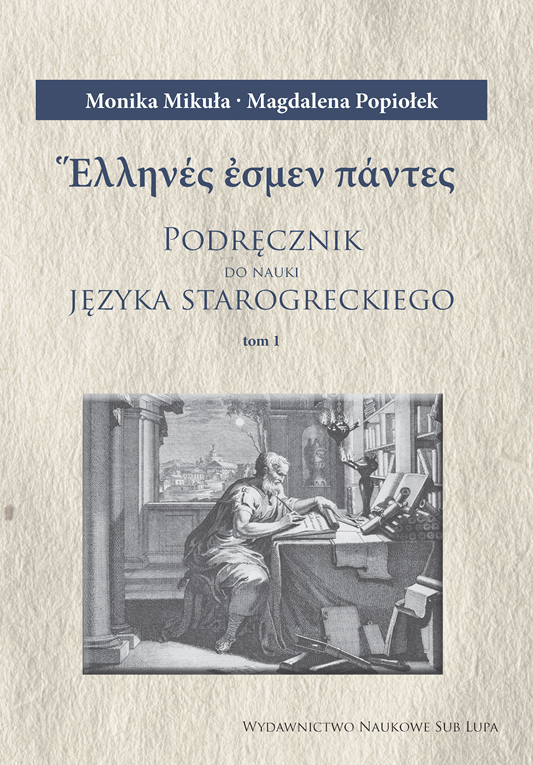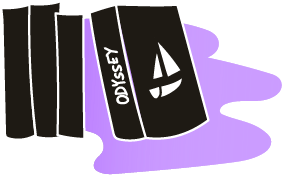Title of the resource
Title of the resource in english
Publisher
Wydawnictwo Naukowe Sub Lupa
Original language
Target and Age Group
The textbook is designed for a two-year course of study for the general public
Author of the Entry:
Marta Pszczolińska, University of Warsaw, m.pszczolinska@al.uw.edu.pl
Peer-reviewer of the Entry:
Elżbieta Olechowska, University of Warsaw, elzbieta.olechowska@gmail.com
Second Peer-reviewer of the Entry:
Ayelet Peer, Bar- Ilan University, ayelet.peer@biu.ac.il
Monika Mikuła
Monika Mikuła is a classical philologist and a Hellenist, currently teaching Greek at the Institute of Classical Studies at the University of Warsaw. She has a considerable educational experience, having taught Latin and Greek at high school, seminary and university since 1990. She is also an experienced translator, both from Ancient and modern Greek. She participated in research on philhellenism in Poland because of her interests in Greek romanticism, especially Dionysios Solomos’ work, and the transformation of Ancient Greek into modern. She is the author of a textbook for learning Christian Greek, Ἑλληνιστὶ γινώσκεις; [Do You Know Greek?], and co-author of an Ancient Greek textbook Ἕλληνές ἐσμεν πάντες.
source: ifk.uw.edu.pl (accessed: August 26, 2019)
Magdalena Popiołek
Magdalena Popiołek is a classical philologist, a university reader and the head of the Workshop on Didactics and Methodology of Latin at the Institute of Classical Studies at the University of Warsaw. She is interested in the methodology and didactics of the classical languages.
source: ifk.uw.edu.pl(accessed: August 26, 2019)
Contents & Purpose
The textbook is founded on both authors’ years of experience in teaching Ancient Greek at the Institute of Classical Studies at the University of Warsaw and at other language classes. It is composed of three volumes. The first includes lessons 1-30 for the first year of study, the second - lessons 31-53 for the second year of study. Both come in two parts - one with texts, the other with grammatical information and sets of exercises. The third volume provides grammatical tables of conjugation and declension, a list of gerund forms of verbs, bonus material about the Ionian, Dorian, Lesbian and Homeric dialects, bonus resources about the phonetic transformation of Ancient Greek into Modern, as well as additional information about ancient metrics, grammatical terminology, Greek-Polish glossary and an onomasiological glossary.
Overall, the authors offer over 1000 pages of knowledge, attractively organized, so that the teacher has a vast choice depending on the interests of students and one’s own common sense of what is needed and what is not. (φρόνησις, vol.1, p.6)
In the volumes 1 and 2, the first sections contain original sentences, Greek sayings, texts for translations along with a glossary and annotations. They also feature introductions describing the context of each text as well as information about history, literature, art, culture, everyday life, religion and mythology relevant to each text. The second sections of these volumes are focused on grammar and feature grammatical explanations, tables of conjugation and declension, exercises and additional vocabulary. The authors teach Greek using original ancient texts (texts are only simplified at the beginning), such texts allow the student to become familiar with the classical works and develop the awareness that Greek as a language tends to ‘surprise’ with exceptions - hence the provided explanations and/or translations of the more difficult phrases that might appear in the texts. The explanations themselves are a vital asset of the textbook with their simplicity and rich exemplification of grammatical concepts, guiding the student to a better understanding and the teacher to easily communicate the complexities of the language.
The parts of the textbook that contain the text focus on the diverse cultural and receptive aspects, which the authors devised carefully and comprehensively. There is more extra-textual material than the raw, original text meant for translation, which incorporates into the language learning process a good proportion of essential knowledge about mythology and relevant symbols, concepts, poems, or works of art.
For example, lesson 5 first comments on the text, provides some information about it, then introduces the text Περὶ Ἀρετῶν καὶ Κακιῶν, following it with a glossary. Below the text, the relevant philosophical concepts of ἀρετή, κακία and ψυχή (anima) are explained as understood by different ancient authors. The authors add their commentary about Hesiod and the Muses, the original hexameters about the Muses from the Theogony along with a glossary, an information box about the Muses illustrated with a painting by Giulio Romano, then an exercise of linking the Muses’ names, attributes and domains (also with a glossary), another box with the Muses’ epithets and 7 fragments of ancient and Renaissance poetry and prose referring to the Muses. Then, the lesson 5 proceeds with 10 Greek maxims with a glossary, an information box about Florilegium by Stobaeus as a priceless source for a philologist, then a few verses from the New Testament, each illustrated with Hosios Loukas’ mosaic and relevant explanations and a glossary. Follows a translation task of the text Thales about the origin of the world by Pseudo-Plutarch, paired with a glossary, an information box about the Thales of Miletus and his contribution to Greek philosophy, and then a cultural text explaining the term ἀρχή - principle. The lesson finishes with a section on the death of Socrates - a Polish text, Greek excerpts with a glossary, illustrations of Bernard Rode’s paintings and another information box describing the administration of justice system in Athens.
By analogy, lesson 22 features a short text about Erinyes, Greek excerpts about the Erinyes from Apollodorus and from Hesiod, accompanied with a glossary, illustrated by European works of art and a box with the translation of an excerpt from Aeschylus’ Oresteia. These are followed by a few sentences to be translated, a box about the fly in culture, and then with Greek couplets - Antipater and Plato about Sappho, along with a glossary, an information box about Sappho illustrated by a Pompeian fresco and a painting by Jacques-Louis David. The lesson finishes with a poem Róże dla Safony (Roses for Sappho) by Maria Pawlikowska-Jasnorzewska.
A similar combination of original Greek texts placed into a historical and cultural context, paired as well with bonus cultural information can be found in every lesson in volumes 1 and 2.
Addenda

Courtesy of the publisher


